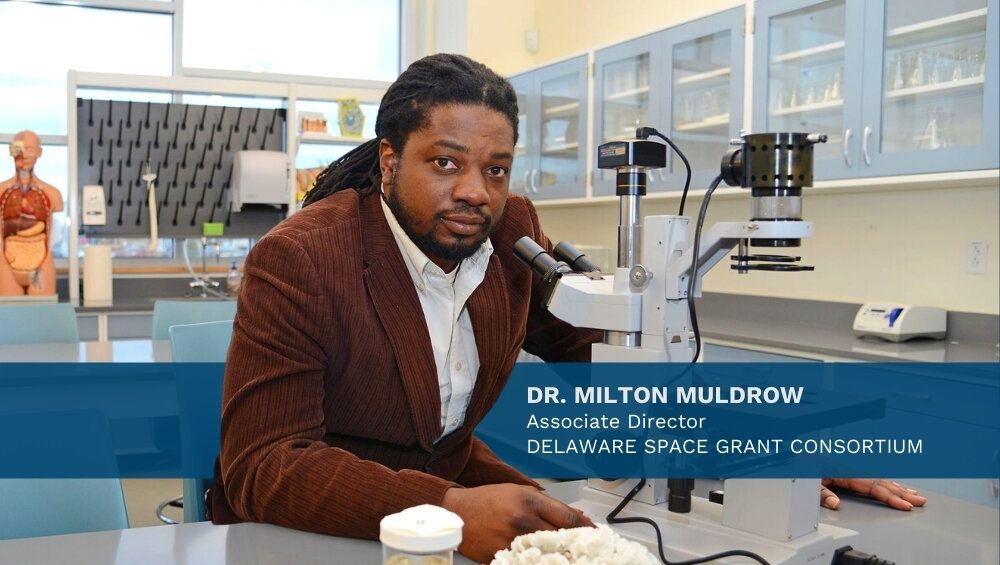Delaware Space Grant Consortium Launches Students into Innovation

September 29, 2021 –
NASA is looking for more than a few good scientists, and Delaware is producing an abundance of them through NASA’s Space Grant program.
According to Dr. Milton Muldrow, chair of Science, Biology, and Environmental Science & Policy at Wilmington University and an associate director of the Delaware Space Grant Consortium, NASA’s National Space Grant College and Fellowship Project provides education and research resources for college-level students who have a potential future with the federal aeronautics and space agency.
NASA created the Space Grant program in 1989. Its national network includes more than 850 affiliates from universities, colleges, industry, museums, science centers, and state and local agencies. These affiliates belong to one of 52 consortia in all 50 states, the District of Columbia, and the Commonwealth of Puerto Rico.
Creating a Tech-Savvy Workforce for the Future
Through the Consortium, Delaware aims to contribute to the technologically literate workforce that NASA and other STEM entities will need in the years ahead.
“The project’s mission is to produce the workforce of the future for NASA,” Muldrow said. “They do this through research engagement for college students, internships and fellowship programs.”
The objectives of Space Grant are to encourage cooperative programs among universities, the aerospace industry, and federal, state and local governments, as well as interdisciplinary education, research, and public service programs related to aerospace. Space Grant also aims to promote a strong science, technology, engineering, and mathematics pipeline through higher education experiences. Muldrow’s introduction to the project came six years ago, when he became chair of Wilmington University’s science programs.
“After we developed science programs at Wilmington University, we immediately tried to align with Space Grant,” he said. “We wanted to offer more opportunities to our students.”
Since then, he added, several students have gotten involved and succeeded.
“My first student to receive a grant through the program created hundreds of maps of coral communities off the Florida Keys based off publicly available data,” Muldrow said. “She did amazing work.”
Interested students work with Muldrow, who submits a proposal to Space Grant based on his research goals. Students who participate in the program come away with tangible deliverables to offer potential employers in their chosen field, along with a notable affiliation.
“The name of the game, coming out of college, is no longer about just a degree,” Muldrow said. “Employers really want to see what you have done. And seeing that a potential employee has participated in a NASA project is a big deal for employers.”
The Space Grant program gives Delaware colleges and universities another means of producing valuable contributors to today’s innovation society.
“When our students get jobs at big labs and institutions, it shows the world the kind of talent we have in Delaware,” Muldrow said. “I’m just blown away every semester, not just by how intelligent the students are, but also how motivated they are.”
When students are accepted into the Space Grant program, they don’t just work on their projects. They also learn how to conduct themselves as scientists and comprehend the importance of being competitive.
“The students learn skills such as working hard and going above and beyond because, at the end of the day, they’re competing with people globally for jobs,” Muldrow said. “Having that NASA banner next to your name is impressive, and our students go on to do great things.”
The Space Grant program also spotlights the work Delaware has contributed to the world of science and technology. Besides Wilmington University, the Delaware Space Grant Consortium includes the University of Delaware, Delaware Technical Community College, and Delaware State University. In Pennsylvania, Swarthmore College and Villanova University are participants.
“It highlights the work that’s already being done in Delaware – work that people may not know,” Muldrow said. “Our director, Dr. William Matthaeus, is world-renowned. He helps develop satellites, including the Parker Solar Probe that launched to the sun.”
Through Space Grant, a group of Wilmington University students recently saw their work launched into space.
“The students helped to build a payload that takes various measurements while in space,” Muldrow explained. “This one went off into space from Wallops Island, Virginia, this spring. That is a national project, and to be represented on the national stage is putting Delaware innovation on the map.”
The student who produced maps of the ocean floor while still enrolled at Wilmington University was offered jobs in her field before receiving her diploma.
“She has moved up quickly,” Muldrow said. “She now works for DNREC – the Delaware Department of Natural Resources and Environmental Control – doing exactly what she did for us: she is a GIS specialist creating maps.”
Another recent graduate entered the Space Grant program with the primary goal of working in a lab. She procured a job at Merck, a pharmaceutical company, using Space Grant as her primary experience when she graduated. And she’s already been promoted.
An additional Wilmington University alum went on to the environmental engineering program at the University of Maryland, Baltimore County, which partners with NASA.
“We have students participating in projects such as GIS mapping, policy research, biological research, and genetic engineering,” Muldrow said. “Our students have gone on to do some amazing things thanks to NASA’s Space Grant Project.”
Newsletter Sign Up
Stay Up To Date With Delaware